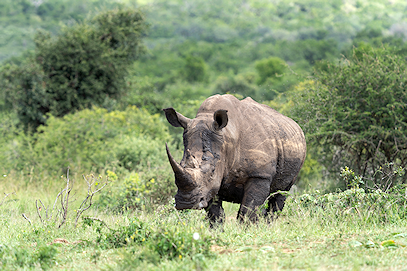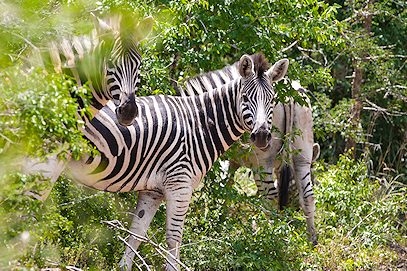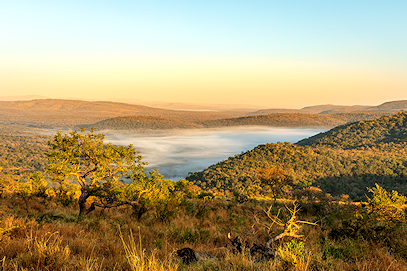Historically Zulu Kings utilized a large part of what is now the Hluhluwe Game Reserve as a royal hunting ground. The area, officially declared a reserve in 1895, is Africa's oldest conservation area. The reserve is one of South Africa's top safari destinations. African Sky offers fly-in safari packages and private overland tours that visit this unique wilderness area.
Need Advice?The Big Five, and the wild dog and cheetah, can be spotted at Hluhluwe-iMfolozi.

An abundance of antelope species occurs here, notably the tiny blue and red duikers and a large nyala population. Bird watchers will be delighted by the more than 400 identified bird species. This South African National Park plays a leading role in conserving black and white rhinos.
This private safari of just over two weeks explores some of the famous national parks in South Africa, accompanied by an experienced African Sky guide.
It is a private tour of the northeastern part of South Africa focused on the wildlife and cultures in the area. We visit the wilderness areas of Kruger and Hluhluwe-iMfolozi, among others.
The Primary safari areas of northern KwaZulu-Natal and the Kruger National Park are the focus of this private overland safari.
Hluhluwe Game Reserve is renowned for its role in rhino conservation: the world-famous Operation Rhino was established here, and the park is the source population of the world's Southern white rhino. The efforts on Hluhluwe's part since the 1950s brought this amazing creature back from sure extinction through innovative conservation efforts that continue to this day.
If you've ever watched "I Dreamed of Africa," starring Kim Basinger, or dreamed of going to Africa you see in the movies, this is the place (it is also the actual place where the movie, and many others, were filmed). The park ticks every box imaginable, and the diversity of its animals and landscapes is like a dream come true.
The fact that this area was the official royal hunting grounds of the Zulu king's Shaka and Dingiswayo should give you an idea of how majestic the park is. Traces of the old Zulu hunting pits and evidence of the forerunners of the Zulus, the San, can be found in and around the park.
As one of South Africa's premier Big Five safari destinations, you'll thrill at the experience of encountering these majestic mammals - particularly black and white rhino, of which Hluhluwe-iMfolozi boasts substantial numbers.



King Shaka International Airport in Durban is a popular national and international flight destination, and flights are available daily from various airports in South Africa. African Sky will ensure that your connecting flight to Durban is scheduled from wherever your journey to Hluhluwe commences, typically OR Tambo in Johannesburg.
Hluhluwe-iMfolozi is situated in what is commonly known as the Zululand district of KwaZulu-Natal, approximately 250km north of Durban. A private, air-conditioned vehicle, driven by one of our experienced guides, will take you through the wild Elephant Coast – nestled between the subtropical islands and the Indian Ocean.
Hluhluwe-iMfolozi is pretty amazing all year round. Its location on the sunny eastern coastline of South Africa correlates with a subtropical climate. It can get quite hot and humid during the rainy summer and spring seasons from September to March, and thunderstorms frequent the area. It is the best time to view the immaculate vegetation, and birding is excellent during the summer.
The winters, however, are not as cold as in other parts of South Africa and make for a comfortable climate throughout the day. Evenings can get cool, but the cloudless skies make this a great time for stargazing. It is also the best time to visit if you are looking for wildlife, as they gather around the waterholes and rivers.
The Hluhluwe-iMfolozi Reserve is the oldest in South Africa and on the entire African continent - it was established in 1895. It was founded because the area's natural abundance of wildlife quickly diminished due to intensive hunting. Hunting escalated when the 'great white hunters' arrived, but it was happening in this area well before that. The Zulu warriors used to dig massive pitfall traps into capturing large numbers of animals along their natural migratory routes. The site is also known for the ancient African tribes that had the knowledge to work metal. Metal tools were made for hunting and farming.
This reserve is probably best known for "Operation Rhino," which was pivotal in saving the white and black rhinos from extinction. The project went so well that the white rhinoceros was removed from the IUCN's Red Data Book of threatened species. This project has restocked more than 3 500 white rhinos to areas where they had become locally extinct. A big problem in the area was the tsetse fly and malaria mosquito, which was thought to eradicate by clearing the area of animals. This occurred to such an extent that the wildebeest and zebra were eliminated around the 1950s. The iMfolozi junction was de-proclaimed as a reserve to enable the use of DDT to fight the tsetse fly and malaria mosquito. It ended in the 1960s, and since then, all wildlife has been very well protected.
Hluhluwe-iMfolozi is one of the classic Big Five reserves. It is also one of the few places where the white and black rhinos can still be seen. It is easier to find the white rhino than the more elusive black rhino that browses in dense thickets. Giraffes and Burchell's zebra are pretty common, as are Cape buffalo. To find elephants and the big cats may be a bit more of a challenge, but they are certainly there. The elephants migrate throughout the park. Cheetahs and lions are occasionally spotted, and there are also rare leopard sightings. Opt for a night drive to improve your chances of seeing leopards or wild dogs.
On a night drive, you may also enjoy a chance encounter with hippos out of the water, as, during the day, you may only sneak a peek at the top of its head and back as it wallows in the waterways. The park is home to large populations of blue wildebeest, impala, kudu, and waterbuck. Rare species that attract enthusiasts are the samango monkey that inhabits the thick forests and the graceful nyala antelope. Birding is excellent, as the park has several bird hides that enthusiastic bird watchers. From Hilltop Camp, many raptors may be seen soaring over the landscape. With more than 340 species recorded, there will undoubtedly be some species even the most committed birders have yet to encounter. Some rare species included the brown-headed parrot, narina trogon, white-fronted bee-eater, and lanner falcon.
Before the parks merged in 1989, the division hindered animals from using what would've been a natural corridor between the grasslands and the forests as the seasons changed. Today they are free to roam where they please, and the natural ecosystem is blossoming. An estimated 1 200 plant species can be found in the region, which includes the Natal giant cycad and pepper bark tree, which are protected species. The Black and White Mfolozi rivers cordon off the Southern parts of the reserve, while the Hluhluwe River originates in the north. Damage to the riverine forests caused by cyclone Demoina in 1984 destroyed many old trees, but saplings have sprouted all around.
Hluhluwe-iMfolozi is an ideal Big Five safari destination. Open vehicle game drives with experienced rangers are conducted in the mornings and late afternoons, and night drives are also available for those overnighting in the park. Supervised walks are also offered, and self-guided foot trails can be explored independently. In addition to the game drives and hikes, hides also allow visitors to view the plentiful wildlife at waterholes and pans. Several picnic sites in the area have 'braai' facilities - ideal for a bush picnic while enjoying the captivating scenery.
The park is one of the few places where guests can experience the activities encompassing rhinos' conservation first-hand. The Centenary Center, in the iMfolozi section, is open to the public and depicts via video and display the history of game capture. Interestingly enough, visitors should keep an eye on the sky because of the attractive birding opportunities and because animals such as rhinos are regularly transported via helicopter to and from various sections of the park.